Access to Computing in Higher Education (2009)
April 21 - 24, 2009
Seattle, WA
The goal of the 2009 AccessSTEM Access to Computing in Higher Education Capacity-Building Institute was to share AccessSTEM project objectives and progress and to brainstorm ideas for future collaborations and activities. Broad issue areas discussed included barriers to STEM for students with disabilities, lessons learned in previous DO-IT projects, and results from DO-IT's longitudinal transition study (ALTS).
The AccessSTEM CBI began with presentations about the AccessSTEM project by project leadership and NSF staff. Following these presentations, small groups worked to brainstorm solutions for increasing participation of students with disabilities in science, technology, engineering, and mathematics fields.
AccessSTEM Capacity-Building Institute outcomes benefit society by making STEM opportunities available to more citizens and enhancing STEM fields with the perspectives of people with disabilities.
Introduction (Access to Computing in Higher Education 2009)
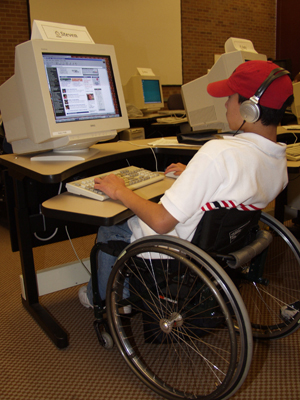
A series of activities were undertaken to better understand the under-representation and increase the participation of students with disabilities in computing and information technology (IT) academic and career fields. These activities were funded by the National Science Foundation (grant #CNS-0540615 and #CNS-0837508). They were coordinated by the Alliance for Access to Computing Careers (AccessComputing) led by the Department of Computer Science and Engineering and DO-IT (Disabilities, Opportunities, Internetworking, and Technology) at the University of Washington (UW).
AccessComputing institutional partners are Gallaudet University, Landmark College, and Rochester Institute of Technology. AccessComputing alliance partners are the Alliance for Students with Disabilities in Science, Technology, Engineering, and Mathematics (AccessSTEM); EAST Alliance for Students with Disabilities in Science, Technology, Engineering, and Mathematics (EAST); Midwest Alliance in Science, Technology, Engineering, and Mathematics (Midwest); Reaching the Pinnacle (RTP); National Center for Women and Information Technology (NCWIT); National Girls Collaborative Project (NGCP); Commonwealth Alliance for Information Technology Education (CAITE); Computing Alliance of Hispanic-Serving Institutions; Empowering Leadership: Computing Scholars of Tomorrow; and Advancing Robotics Technology for Societal Impact Alliance (ARTSI).
Goal and Outcomes
AccessComputing works to increase the participation of people with disabilities in computing and IT fields. Collaborators apply evidence-based practices to:
- increase the number of students with disabilities successfully pursuing degrees and careers in computing fields
- increase the capacity of postsecondary computing departments to fully include students with disabilities in computing courses and programs
- create a nationwide resource to help students with disabilities pursue computing fields
- help computing educators and employers, professional organizations, and other stakeholders develop more inclusive programs and share effective practices nationwide
Capacity-Building Activities
AccessComputing collaborates with project partners in a variety of ways, to:
- conduct a Capacity-Building Institute (CBI)
- share results of the CBI with other institutions and individuals
- provide an electronic forum to continue discussion of veterans issues, and provide support of efforts to increase services and supports for veterans
- extend resources to other programs and promising practices via an online searchable AccessComputing Knowledge Base
Audiences for These Materials
This publication was created for people who:
- participated in the Access to Computing in Higher Education Capacity-Building Institute held in April 2009 in Seattle
- want to conduct a CBI at their institution, in their region, or at a national or international forum
- seek to increase their understanding of issues surrounding the underrepresentation and participation of students with disabilities in computing studies and careers
- are motivated to join an electronic community to discuss these issues
- would like to access resources for making their campus courses, services, and activities more welcoming and accessible to students with disabilities
- have promising practices for serving students with disabilities in computing to share with others
About the CBI (Access to Computing in Higher Education 2009)
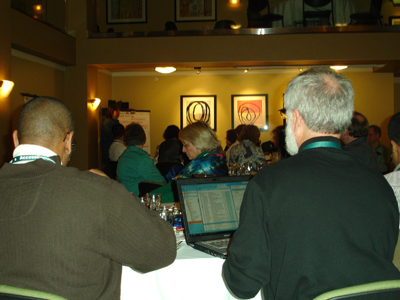
The Access to Computing in Higher Education Capacity-Building Institute took place April 21 - 24, 2009, in Seattle, WA. Its overall purpose was to explore ways to increase the participation and success of students with disabilities in computing and IT postsecondary studies and careers.
Participants in this two-and-one-half-day event included student service leaders, administrators, and teaching faculty from institutions around the county. Hosted by the University of Washington (UW), the CBI provided a forum for comparing recruitment and access challenges, sharing successful practices, developing collaborations, and otherwise increasing the capacity of institutions to serve students with disabilities in computing and IT fields. Specific goals of this CBI were to:
- bring together campus and community members who represent students with disabilities, faculty and administrators in IT and computing, and programs that serve to broaden participation in computing and IT fields
- share best practices and develop new practices that will increase the number and success of students with disabilities in computing and IT fields
- learn about accessibility, universal design, and funding opportunities to increase the participation of students with disabilities in computing and IT fields
- network with colleagues from around the country
Speakers and panelists were also CBI participants and shared their expertise on a variety of topics related to computing, IT, and student success. Broad issues that were discussed included:
- access to higher education curricula and courses through universal design of education and accommodations
- best practices for outreach to veterans with disabilities in higher education
- strategies to develop effective partnerships between disabled student services offices, computing departments, veterans organizations, and other campus services
- increasing access to computing and IT through assistive technology
- developing accessible computing and IT curricula
- assisting students with disabilities in their transitions to computing and IT graduate education and careers
In this CBI:
- All participants contributed to its success.
- Experts in all topic areas were in the audience.
- Although some of the CBI content was predetermined, discussions and presentation content changed as the meeting unfolded and participant interests were expressed.
The CBI was comprised of panel and individual presentations and working group discussions. Panel discussions and individual presentations offered participants opportunities to discover ways to make computing and IT programs welcoming and accessible for students with disabilities. Working group discussions allowed participants time to gather in small groups and explore answers to the following questions:
- What are the barriers and challenges that students with disabilities face in pursuing computing undergraduate and graduate academic programs and careers?
- How can disability support services, computing departments, veterans organizations, and other groups work together effectively to increase the number of people with disabilities in the computing sciences?
- How can disability-related topics be integrated into the computing and IT classroom curriculum on your campus?
- What specifically can your computing department, disability support services office, veterans organization, or other campus service do to improve the recruitment and support of students with disabilities in computing and IT departments and careers?
Agenda (Access to Computing in Higher Education 2009)
Tuesday
7:00 - 9:00 p.m.
Evening Social
Wednesday
8:00 - 9:00 a.m.
Buffet Breakfast & Networking
9:00 - 10:00 a.m.
Welcome
- Complete pre-test
- Institute objectives and schedule
- Introductions Housekeeping details: Restrooms, breaks, and meals
- Accessibility of the CBI
- CBI materials
- AccessComputing: Goals, objectives, activities, and products
- View video: Taking Charge: Stories of Success and Self-Determination
- Sheryl Burgstahler, AccessComputing Co-Director, University of Washington
10:00 - 10:45 a.m.
Best Practices: Higher Education Consultation and Outreach for Veterans with Disabilities
Peter Schmidt, Washington Department of Veterans Affairs and Edmonds Community College
10:45 - 11:00 a.m.
Break
11:00 a.m. - 12:30 p.m.
Working Together: Disabled Student Services, Computing Departments, Veterans Organizations, and Other Campus Services
Panel:
- Adele Darr, Arizona State University
- Feng Wang, Arizona State University
- Rodney Pennamon, Georgia State University
- Carl Stucke, Georgia State University
- Meryl Berstein, Johnson and Wales University
- Donna LaPorte, Johnson and Wales University
- Judy Elimelech, Missouri Southern State University
- Lyle Mays, Missouri Southern State University
Moderator: Sheryl Burgstahler
12:30 - 1:45 p.m.
Lunch and Working Group Discussion
Question 1: What are challenges students with disabilities face in pursuing computing undergraduate and graduate academic programs and careers?
1:45 - 2:30 p.m.
Debriefing and Discussion: Interventions, Minigrants, and Other Opportunities
Sheryl Burgstahler, AccessComputing Director
Tami Tidwell, AccessComputing Program Coordinator
2:30 - 3:00 p.m.
View video: World Wide Access: Accessible Web Design
Provide suggestions for making this video more useful.
3:00 - 3:15 p.m.
Break
3:15 - 4:15 p.m.
Working Group Discussion
Question 2: How can disability support services, computing departments, veterans organizations, and other groups work together effectively to increase the number of people with disabilities in the computing sciences?
4:15 - 4:45 p.m.
Working Group Reports
Working group representatives each deliver a three-to-five minute summary of their group's discussion and accomplishments.
4:45 - 5:00 p.m.
Preview of Tomorrow's Agenda, Daily Feedback
Complete daily feedback form.
5:00
Adjourn
6:30 - 8:30 p.m.
Dinner, Networking, and Discussion of Future Collaborations
Thursday
8:00 - 9:00 a.m.
Buffet Breakfast & Networking
9:00 - 9:45 a.m.
Universal Design in Education
View video: Equal Access: Universal Design of Computer Labs
Sheryl Burgstahler
9:45 - 10:45 a.m.
Opening Doors with Assistive Technology
Dan Comden, Access Technology Consultant, UW
10:45 - 11:00 p.m.
Break
11:00 a.m. - 12:00 p.m.
Putting the Pieces Together: Accessible Design of Technology
Terry Thompson, AccessComputing Technology Accessibility Specialist, UW
Wendy Chisholm, Web Accessibility Specialist, UW
12:00 - 12:30 p.m.
Bringing Accessibility to Computing and IT Curricula
Richard Ladner, AccessComputing Co-Director
12:30 - 1:45 p.m.
Lunch and Working Group Discussion
Question 3: How can disability-related topics be integrated into the computing and IT classroom curricula on your campus?
1:45 - 2:00 p.m.
Working Group Reports
Working group representatives each deliver a three-to-five minute summary of their group's discussion and accomplishments
2:00 - 3:00 p.m.
Careers in Computer Science and Disability
Richard Ladner
2:00 - 3:15 p.m.
Break
3:15 - 3:30 p.m.
View video: Part of Me, Not All of Me
3:30 - 4:45 p.m.
Our Paths to Computing Careers
Panel:
- Anna Golden, Student
- Jason Grieves, Program Manager, Microsoft
- Ted Hart, Software Engineer, Microsoft
- Daman Wandke, Student and Disability Activist
Moderator: Sheryl Burgstahler
4:45 - 5:00 p.m.
Preview of Tomorrow's Agenda, Daily Feedback
Complete daily feedback form.
5:00
Adjourn
Friday
8:00 - 9:00 a.m.
Buffet Breakfast, Networking, and Discussion
9:00 - 9:30 a.m.
Overview of Agenda
9:30 - 10:45 a.m.
Transition Challenges and Promising Practices for Individuals with Disabilities
Sheryl Burgstahler
Richard Ladner
- High school to college
- Two-year schools to four-year schools
- Undergraduate to graduate studies
- School to work
10:45 - 11:00 a.m.
Directions for Working Groups
11:00 - 11:15 a.m.
Break
11:15 a.m. - 12:00 p.m.
Working Group Discussion
Question 4: What specifically can your computing department, disability support services office, veterans organization, or other campus service do to improve the recruitment and support of students with disabilities in computing departments and careers?
12:00 - 1:00 p.m.
Lunch and Collaborative Meeting Evaluation
Complete post-test and place in the evaluation box.
Participants (Access to Computing in Higher Education 2009)
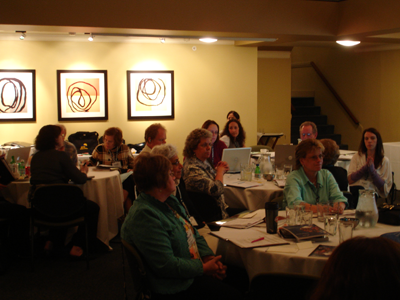
Stakeholder groups represented in the CBI included:
- student services leaders and administrators
- computing faculty
- technology specialists
- individuals working for student-serving organizations
The following individuals participated in the CBI:
Susan Ackerman
Disability Services Director
Rochester Institute of Technology
smacst@rit.edu
Meryl Berstein
Director
Johnson & Wales University
mberstein@jwu.edu
Sheryl Burgstahler
Co-Director, AccessComputing
University of Washington
sherylb@uw.edu
Wendy Chisholm
Web Accessibility Specialist, DO-IT
University of Washington
chisholm.wendy@gmail.com
Dan Comden
Access Technology Consultant
University of Washington
danc@uw.edu
Lyla Crawford
Program Coordinator, DO-IT
University of Washington
lylac@uw.edu
Marvin Crippen
Technology Specialist, DO-IT
University of Washington
mcrip@uw.edu
Stephanie Crosby
Coordinator, Disability Support Services
Tallahassee Community College
crosbys@tcc.fl.edu
Adele Darr
Director
Arizona State University West
adele.darr@asu.edu
Todd DeVries
ADA Coordinator
Idaho State University
devrtodd@isu.edu
Judy Elimelech
Coordinator for Disability Services
Missouri Southern State University
elimelech-j@mssu.edu
Shawn Foster
Assistive Technology Specialist
Southern Oregon University
fosters@sou.edu
Haris Gunadi
Program Manager, Technology and Production Support Services
Disability Access Services
Haris.Gunadi@oregonstate.edu
Doug Hayman
Technology Specialist, DO-IT
University of Washington
dhayman@uw.edu
Irene Jones
Coordinator, Disability Resources & Services
Eastern Idaho Technical College
Irene.Jones@my.eitc.edu
Sijo Jose
Specialist
University of Maryland Baltimore County
sijo007@gmail.com
Ravi Kuber
Assistant Professor
University of Maryland Baltimore County
rkuber@umbc.edu
Richard Ladner
Co-Director, AccessComputing
University of Washington
ladner@cs.washington.edu
Jennifer Landefeld
ARTSI Alliance Project Manager
Carnegie Mellon University
jennsbl@cs.cmu.edu
Samantha Langley
EAST
University of Southern Maine
langley@usm.maine.edu
Donna Laporte
Systems Administrator
Johnson & Wales University
dlaporte@jwu.edu
Lynn Lovewell
Director, EAST
University of Southern Maine
llovewell@usm.maine.edu
Stephanie Ludi
Assistant Professor
Rochester Institute of Technology
salvse@rit.edu
Mary Matthews
Director, Disability Services
University of Alaska Fairbanks
fnmkm@uaf.edu
Lyle Mays
Professor, Computer Information Science
Missouri Southern State University
mays-l@mssu.edu
Phil McGilton
Assistive Technology Specialist
Bellevue College
pmcgilto@bellevuecollege.edu
Ashley Mog
Program Assistant, DO-IT
University of Washington
amog1@uw.edu
Candida Mumford
Coordinator, Student Disability Services
College of Southern Idaho
cmumford@csi.edu
Rodney Pennamon
Director
Georgia State University
rpennamon@gsu.edu
Greg Pleva
Professor
Southern Oregon University
pleva@sou.edu
Sharon Robertson
Assistant Director
University of Tennessee Martin
sroberts@utm.edu
Dorothy Skidmore
Administrative Director
Technology Development Workshop
skid@dwinc.org
Lisa Stewart
Program Coordinator, DO-IT
University of Washington
lstew2@uw.edu
Mel Stone
Instructor
Eastern Idaho Technical College
melvin.stone@my.eitc.edu
Carl Stucke
Associate Chair, CIS
Georgia State University
cstucke@gsu.edu
Keith Swarner
Associate Professor, Computers and Information Technology
University of Alaska Fairbanks
keith.swarner@alaska.edu
Dustin Thomas
Desktop Support
Bellevue College
dthomas@bellevuecollege.edu
Terrill Thompson
Technology Accessibility Specialist, AccessComputing
University of Washington
tft@uw.edu
Tami Tidwell
Program Coordinator, DO-IT
University of Washington
tamitha@uw.edu
Feng Wang
Assistant Professor
Arizona State University
fwang25@asu.edu
Glenn Wilson
University of Southern Maine
gwilson@usm.maine.edu
Patti Lester
Coordinator/Interpreter, Deaf Services
Florida State University
plester@fsu.edu
Presentation Summaries (Access to Computing in Higher Education 2009)
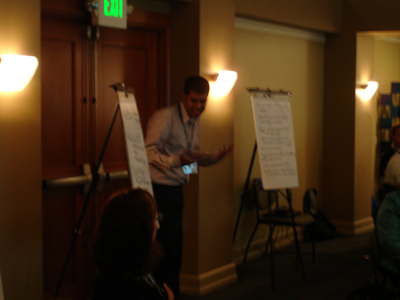
Best Practices: Higher Education Consultation and Outreach for Veterans with Disabilities
Peter Schmidt, Washington Department of Veterans Affairs
Most people either are a veteran, know a veteran, or have a friend or family member who is a veteran. Veterans are pervasive throughout society and on college campuses. On college campuses, veterans are not often identified or tracked effectively by admissions and student affairs offices. Conducting events that celebrate the work of veterans creates a veteran-friendly atmosphere on campus for all student veterans, including those who have not been identified by the college or university.
Many student veterans who are transitioning to the college environment from the military have experienced a variety of war zone stressors. Including environmental (e.g., extreme climates), emotional, battle-related trauma, and physical (e.g., strains and other orthopedic problems). Stressors that affect soldiers while they are deployed continue to affect them when they return home, and stress can be magnified by multiple deployments and extended tours of duty. Some soldiers are also dealing with issues related to grief and loss, sexual assault, and the burden of killing. Student veterans may feel alienation and distance from other students on campus. Faculty, staff, and students can play important roles in bridging the cultural gap and providing support for student veterans
College campuses offer more choices than a typical veteran had when they enlisted in the military. The wide range of options can be overwhelming to some student veterans. Mentoring relationships with faculty and staff, especially if those faculty and staff are veterans themselves, can help student veterans in their transition to campus life by providing opportunities to talk and ask questions related to the differences in the cultures between college and the military.
While developing a process that is welcoming to student veterans, consider the following:
- How would a person know if your campus is veteran-friendly?
- How comfortable would a veteran with a disability be on your campus?
- What strategies can be employed to address issues related to these questions?
Some practices to consider in building a veteran-friendly campus include the following:
- Listen to student veterans; hold a round table to solicit feedback from students about their needs and experiences.
- Assess the strengths and weaknesses of the institution, including what resources are available for veterans and how information about those resources is communicated.
- Develop a veterans association or club to provide a gathering place for veterans; talk to the students about where to locate the gathering place in order to create a safe space.
- Create a central point of contact for student veterans, for example a Dean of Veteran Affairs, a veterans resource team, or a certifying official; from that location, counselors can connect veterans to relevant campus services such as the disabilities services office.
- Provide student orientations specifically for veterans.
- Partner with other organizations such as the Veterans Administration, Work Source, the VFW, and American Legion to provide on-campus programs and services.
- Include resources for veterans in the key college catalogs, guides, and websites.
- Educate faculty, staff, and students about veteran issues.
Universal Design in Education
Sheryl Burgstahler, AccessComputing Co-Director
Universal design is about making things usable for the most people possible. Universal design is an attitude that values diversity, equity, and inclusion; a goal; and a practice that makes products and environments welcoming, accessible, and usable. Often the diversity of users is not visible; for example, many disabilities (such as learning disabilities) are not obvious. Universal design is beneficial for people with disabilities, and also for those with diverse characteristics with respect to age, gender, race, ethnicity, etc.
Some examples of universal design include the following:
- Assessment—test in a predictable way that students have experienced before.
- Training software—helps users when they don't choose an appropriate selection.
- Science lab—an adjustable-height workstation table that can be used by people with a wide range of physical abilities.
- Purchasing new products—ask vendors about the accessibility of their products and express your preference for purchasing accessible products to raise awareness.
Universal design can be applied to instruction, services, physical spaces, and technology. Being proactive minimizes the need to be reactive. Universal design of learning provides multiple means of representation, expression, and engagement. It allows students multiple ways to engage in class discussions and activities. Applying universal design to information technology minimizes the need for assistive technology and accommodations. It is important to think about how you might address the needs of students with various types of disabilities when planning classes, before you know whether or not you have someone with a disability in your class.
Often inaccessibility is blamed on the disability. Instead, take a universal design approach to accessibility by first focusing on making the environment, programs, and resources more accessible.
Opening Doors with Assistive Technology (AT)
Dan Comden, Access Technology Lab Manager, UW
AT is any product that makes it possible for a person with a disability to perform a task that is not normally accessible to them. Some examples of AT include a wheelchair, a magnifying glass, an automatic door opener, and hardware or software that provide access to computing.
Listed below are examples of AT often used by people with certain types of disabilities.
People with mobility or communication impairments might use:
- adjustable-height desks
- building, room, and furniture accessibility
- different types of keyboards (e.g., ergonomic, touchscreen, virtual)
- graphical user interface pointer (e.g., joystick, mouse alternative, touchpad, ProPoint, Thumbelina)
- keyboard layout (Dvorak, QWERTY)
- keyboard shortcuts
- Microsoft's StickyKeys for Windows
- speech input
- switch input (e.g., scanning, Morse code)
- word prediction software
- wrist rests or arm supports
People with learning disabilities might use:
- scanning with optical character recognition
- talking word processors
- speech output with highlighting functionality
- prosthetic memory devices, such as cell phones or laptops
- speech-to-text functionality
People with sensory impairments might use:
- a large monitor
- video magnifiers
- enlarged keyboard labels
- screen enlargement options (including the ability to increase font size and decrease resolution)
- speech output—synthesizer (dedicated or via a computer-based sound card)
- document scanner/screen readers
- Braille—refreshable display, embossed output
- tactile graphics
When considering AT procurement it is important to strike a balance between what is cost effective, usable by the student, and appropriate for the task(s).
Putting the Pieces Together: Accessible Design of Technology
Terry Thompson, Technology Accessibility Specialist, University of Washington
Wendy Chisholm, Web Accessibility Specialist, University of Washington
Even when using AT, online content or software can be inaccessible because of its design. For example, if a person using a screen reader attempts to access a website that uses images, the visual content in those images will be inaccessible unless the webmaster included meaningful alternative text (alt tags) that is formatted in a way that a screen reader can interpret.
The AccessComputing project has done research on the current state of web accessibility. Part of this research was a longitudinal study that included the manual assessment of 127 higher education institution home pages in Washington, Oregon, Idaho, and Alaska. These sites were evaluated in 2004-2005 and again in 2009. Researchers looked at accessibility and meaningfulness of alt tags. In 2004-2005, 27% of pages reviewed were accessible. In 2009, this number grew to 41%.
Researchers discovered that using colors to convey information is a common design strategy. This technique is also a problem for people with visual impairments and color blindness. Researchers also discovered that online videos often lack accessibility features. The most common problem is that videos do not have captioning. To address this issue, campuses need to develop a system for captioning or providing transcripts. Programs exist that can help with video captioning. Examples include Amazon Turk, Magpie, and Automatic Sync Technologies. Besides making content accessible to individuals with hearing impairments, adding video captions allows all users to search text from video transcripts, a highly desirable capability in the online environment.
Additional statistics revealed by this longitudinal study include the following:
- 7% of home pages had "skip to main content links" in 2004-2005, 19% in 2009.
- 45% of home pages correctly used HTML headings.
- 78% of home pages were accessible in 2004-2005 by keyboard navigation, 66% in 2009 if visual focus is not considered. If we consider visual focus, only 13% of home pages were accessible.
- 39% of home pages had dynamic scripted menus.
- Using colors to convey information is a common design strategy. This technique is a problem for people with visual impairments and color blindness.
- 38% of home pages included flash; forty out of 127 home pages had informative flash content with operable controls; of these, one added basic accessibility, such as text labels on buttons and other controls.
Thompson, T., Burgstahler, S., Moore, E. (2010). Web accessibility: A longitudinal study of college and university home pages in the northwestern United States. Disability and Rehabilitation: Assistive Technology, 5(2), 108-114.
Careers in Computer Science and Disability
Richard Ladner, AccessComputing Co-Director
Computing has changed the way we live, work, learn, and communicate. Computing drives advances in many fields and enables growth and development in our economy.
Employment opportunities in computing are growing at a fast rate and jobs in computing fields also tend to be associated with high salaries. People pursue diverse careers following their computer science and IT education. They might not necessarily migrate to a strict programming position. People enter computing and IT fields for a variety of reasons. Diversity in academic and employment settings leads to better solutions. It is therefore desirable to increase the participation of under-represented groups in computing and IT fields. These include women and people with disabilities.
National Science Foundation (NSF) data shows that 18% of students with and without disabilities are interested in natural science and engineering. Of postsecondary students with disabilities, more than 50% attend public two-year schools and nearly 40% attend public four-year schools. These students are less likely than students without disabilities to complete a bachelor's degree; some data revealed that only 40% of students with disabilities attained bachelor's degrees, versus 60% of all students. Graduate students with disabilities are less likely than graduate students without disabilities to major in natural science and engineering. NSF estimates that people with disabilities make up 11% of the STEM undergraduate student population, 7% of the STEM graduate student population, 1% of all STEM doctorate recipients, 5% of the STEM workforce, 8% of all STEM doctorate faculty, 16% of the population, and 10% of the U.S. workforce.
Students with disabilities tend to drop out of computing majors more than other students, and very few students with disabilities pursue advanced degrees in computing. Some notable exceptions include Steven Hawking, a world-renowned physicist; TV Raman at Google; Christian Vogler, who has worked on sign language recognition; Chieko Asakawa, who worked on social accessibility to improve accessibility of web pages; and Jonathan Kuniholm, who is a veteran working on prosthetic limbs. People with disabilities can succeed in many scientific fields and some are highly motivated to pursue careers in accessibility research.
Transition Challenges and Promising Practices for Individuals with Disabilities
Sheryl Burgstahler and Richard Ladner, AccessComputing Co-Directors
Transitions between educational levels are difficult for many students, especially for students with disabilities, because the support services in college are not the same as in high school. Institutions vary in services offered, and students must self-advocate to receive accommodations. One longitudinal study found that while 77% of students with disabilities listed college attendance as a goal, only 31% actually went to college.
Some strategies for increasing the success of students with disabilities transitioning from high school to college include the following:
- Talk to prospective students about assistive technology before they get to college level studies; train prospective students on technology that can help them succeed
- Plan a statewide transition conference for students with disabilities hoping to go to college. Host campus tours and information sessions about applying for college Create online mentoring communities for students with disabilities
- Engage with existing high school-to-college transition events in order to outreach to students with disabilities
- Educate high school teachers, counselors, and transition specialists about accessing accommodations in college
Some strategies for improving transition outcomes for students with disabilities from two-year to four-year schools include the following:
- Invite disability services staff from universities to talk to community college students about accommodations and accessibility at the university level
- Work with project staff to publish an Opportunities! newsletter for your campus that includes information about AccessComputing, other resources, and events
Some strategies for improving transition outcomes for students with disabilities from undergraduate to graduate school include the following:
- Provide opportunities for undergraduates to become involved in research
- Enable connections between undergraduates and graduate student mentors
- Facilitate meetings between faculty and students to talk about research opportunities
Finally, some strategies for improving transition outcomes for students with disabilities from school to work include the following:
- Host transition workshops
- Provide opportunities for students to practice interviewing and develop resumes
- Offer internship opportunities
- Distribute resources to employers about hiring people with disabilities
Reports from Panel Discussions (Access to Computing in Higher Education 2009)
Working Together: Disabled Student Services, Computing Departments, Veterans Organizations, and Other Campus Services
Representatives from several institutions around the country shared their experiences and ideas for fostering collaborations between departments to create programs that support students. A summary of ideas and programs from each campus follows.
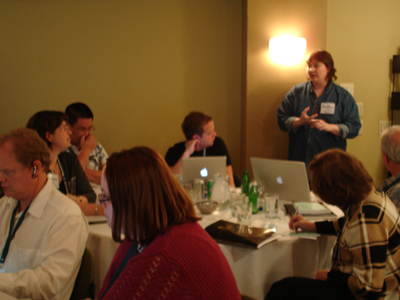
Rodney Pennamon and Carl Stucke, Georgia State University (GSU) reported:
- GSU has 500 registered student veterans on campus and GSU officials suspect that there are many more unidentified student veterans--some with disabilities.
- GSU addresses veterans issues through a veterans coordinating council that includes the disability services office, the student support services office, the Dean of Student Services, the career services office, the veterans services office, Reserve Officers' Training Corps, and Veterans Affairs (VA) coordinator.
- GSU's disabilities services office implemented recommendations from a meeting with the veterans center to better serve student veterans with disabilities.
- GSU's career services office created From Combat to Private Sector, a program to help veterans match the skills and knowledge they gained from their military assignments to civilian occupations.
- GSU partnered with another university to host a webinar on veterans affairs.
- The disability services office screened a film on post traumatic stress disorder (PTSD).
- GSU has developed a process for integrating veterans into existing internship programs.
- A GSU master's program in computer science is establishing a relationship with a Major General at a local military base that will help student veterans bridge the gap to college studies and careers.
- GSU increased the number of classes offered through online learning and is working to ensure that these classes are accessible to students with disabilities.
- GSU is reaching out to returning veterans through local military installations and considering offering degree programs on-site at a local base.
Meryl Berstein and Donna LaPorte, Johnson and Wales University (JWU) reported:
- JWU coordinates services for students on both of its campuses out of one central office.
- Faculty and staff are trained on how to respond to accommodation requests.
- Decisions about technology-related accommodations for students with disabilities are made by an assistive technology committee on campus.
- JWU uses assistive technology as a tool to help all students transition and succeed in college studies. A community of practice for assistive technology helps staff work proactively with students and with facilities to accommodate requests in a timely manner.
Adele Darr and Feng Wang, Arizona State University (ASU) reported:
- ASU has four campuses that collaborate to provide services to students with disabilities.
- ASU is currently developing relationships between the disability services office and academic departments by helping faculty build confidence to respond to students with disabilities who need accommodations.
- ASU hosts a community of practice that meets twice a semester; this community has developed strong relationships and works on making the campus more accessible.
- ASU fosters a strong relationship between disability services personnel and the veterans coordinator; work continues to be done to identify and reach out to student veterans.
- Disability services staff collaborate with faculty to respond effectively to student accommodation needs in the classroom.
- ASU is currently developing a program that will integrate students with disabilities into group computing projects to increase their success and engagement. ASU offers an accessible computer lab with staff to help students with the equipment and software.
Judy Elimelechm and Lyle Mays, Missouri Southern State University (MSSU) reported:
- MSSU is currently organizing services for student veterans, including a website with a compilation of resources and services.
- Regular meetings of veteran, financial aid, counseling service, and other departmental representatives address access issues.
- MSSU collaborates with local veterans associations to build alliances.
- MSSU hosted a webinar on serving veterans and conducted a veterans open house.
- The MSSU disability services office works with campus computing organizations to offer assistive technology and to increase the accessibility of IT.
Reports from Working Group Discussions (Access to Computing in Higher Education 2009)
CBI participants represented a wide range of stakeholders, including postsecondary faculty and staff, and employees of organizations serving students around the country. They brainstormed and shared ideas about how to better serve students in computing fields in postsecondary education. The following summarizes their discussions.
Question 1
What are challenges that students with disabilities face in pursuing computing undergraduate and graduate academic programs and careers?
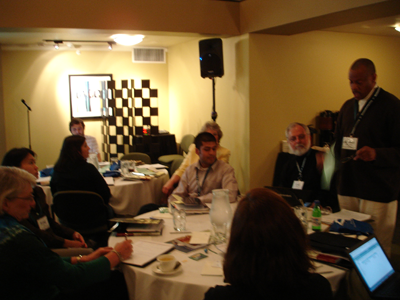
- Some students are unprepared for the rigor of college-level studies, lacking skills such as effective note taking and study habits; others lack the prerequisite knowledge base for success.
- Some students find it difficult to complete remedial classes and progress to higher level classes.
- Some have difficulty navigating the admissions process.
- Some cannot adjust to the changing level of support received. Some physical spaces, curricula, and services are inaccessibly designed.
- Some students lack of knowledge about resources available to them, including assistive technology and how to use it.
- Faculty and teaching assistants are unsure of how to work with students with disabilities.
- Some faculty members have inaccurate perceptions regarding the abilities of people with disabilities. These low expectations can be challenging to overcome.
- Some students cannot find available and appropriate financial resources, including those to fund the purchase and upgrade of assistive technology.
- Some employment options in community businesses are inaccessible to potential workers with disabilities.
Question 2
How can disability support services, computing departments, veterans organizations, and other groups work together effectively to increase the number of people with disabilities in the computing sciences?
- Create a clearinghouse of information for students interested in pursuing computing and IT degrees.
- Ask for student input and advertise the resource to high school administrators and students.
- Clarify and improve military transfer articulations with colleges through collaborations with local VA offices.
- Teach students how to self-advocate effectively.
- Survey students with disabilities to get a better idea of their needs and barriers to participation.
- Address identified needs and work to remove barriers to increase classroom participation.
- Introduce assistive technology software and hardware solutions to students with disabilities.
- Demonstrate assistive technology at faculty and staff meetings.
- Install assistive technology applications in all computer labs.
- Provide internships early in the student academic careers.
- Conduct a needs assessment of potential employers and disseminate the information to students.
Question 3
How can disability-related topics be integrated into the computing and IT classroom curricula on your campus?
- Consider related accessibility and universal design topics for all class curricula.
- Include accessibility as a component to each assignment or subject studied.
- Ask an individual with a disability to present content about assistive technology and accessibility so that students can hear first hand about accessibility issues; consider providing a panel of individuals with a variety of disabilities and computing needs.
- Have students assess the accessibility of campus or business websites.
- Offer faculty training on assistive technology and accessibility that will provide them with knowledge to bring back to their classrooms.
- Develop an online resource about assistive technology or other disability-related topic.
- Work with book publishers to both include accessibility content in their curricula and provide books and supplemental classroom materials in an accessible electronic format.
Question 4
What specifically can your computing department, disability support services office, veterans organization, or other campus service do to improve the recruitment and support of students with disabilities in computing departments and careers?
- Through training and resources, increase awareness of accessibility issues and the need for universal design.
- Establish a presence at campus workshops by inviting panels of students with disabilities or speakers with disabilities to address campus accessibility needs.
- Develop courses and informational workshops on computing and assistive technology.
- Teach faculty about disability services, accommodation expectations, and assistive technology options.
- Collaborate with veterans-serving organizations on hosting informational sessions and workshops on course options in computing for people with disabilities.
- Email students with disabilities about upcoming informational sessions and internship opportunities.
- Ask students to think creatively about internships.
- Foster connections to the art department, filmmaking, journalism, and other fields using digital media.
- Ensure that computer science and IT classrooms are physically accessible.
AccessComputing Website and Searchable Knowledge Base (Access to Computing in Higher Education 2009)
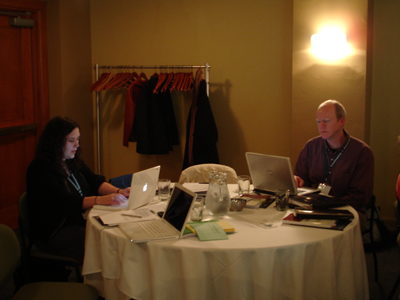
The AccessComputing website contains:
- information about project goals
- the application of evidence-based practices toward project deliverables
- resources for students with disabilities
- educational materials for postsecondary faculty and staff
- information about partners and collaborators
- program applications
DO-IT maintains a searchable database of frequently asked questions, case studies, and promising practices related to how educators and employers can fully include students with disabilities in computing activities.
The Knowledge Base can be accessed by following the "Search AccessComputing Knowledge Base" link on the AccessComputing website.
The Knowledge Base is an excellent resource for ideas that can be implemented in programs in order to better serve students with disabilities. Individuals and organizations are encouraged to propose questions and answers, case studies, and promising practices. In particular, the promising practices articles serve to spread the word about practices that show evidence of improving the participation of people with disabilities in computing. Contributions and suggestions can be sent to doit@uw.edu.
Examples of Knowledge Base questions include the following:
- How can I make my computing department more accessible to students with disabilities?
- Universally Designed Webpages: A Case Study on Access Issues for a Student with a Learning Disability
- What adaptive technology is typically provided to students with disabilities on postsecondary campuses?
- What are specific computer applications that can assist students with learning disabilities?
- Are there any web-based tutorials on web accessibility?
- How can principles of universal design be used to construct a computer lab?
Acknowledgments (Access to Computing in Higher Education 2009)
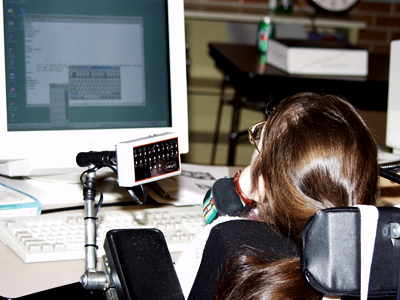
AccessComputing capacity-building activities were funded by the National Science Foundation (grant #CNS-0540615 and #CNS-0837508). They were coordinated by the Alliance for Access to Computing Careers, which is led by the Department of Computer Science and Engineering and DO-IT at the University of Washington. Any opinions, findings, and conclusions or recommendations expressed in this material are those of the CBI presenters and publication authors, and do not necessarily reflect the views of the National Science Foundation.
Some of the content of this publication is taken with permission from the DO-IT website. Permission is granted to modify and duplicate these materials for noncommercial purposes provided the source is acknowledged.
Electronic versions of this publication are available in print-ready and accessible formats at the DO-IT website.